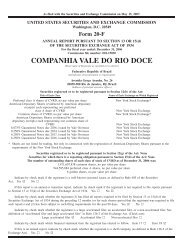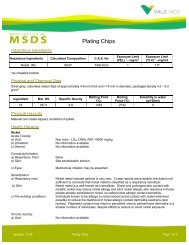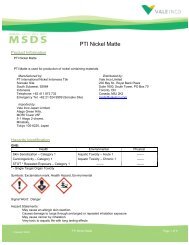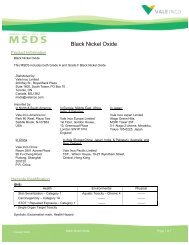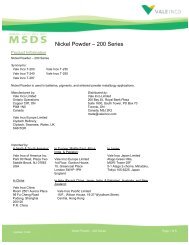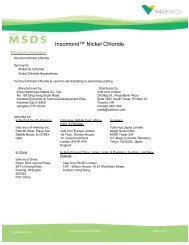You also want an ePaper? Increase the reach of your titles
YUMPU automatically turns print PDFs into web optimized ePapers that Google loves.
a) Respiratory tract: Nickel metal induced asthma is very rare. 3 case reports are available; the data<br />
is not sufficient to conclude that nickel metal is classified as a respiratory<br />
sensitizer.<br />
b) Skin: Nickel metal is a well-known skin sensitizer. Direct and prolonged skin contact<br />
with metallic nickel may induce nickel allergy and elicit nickel allergic skin<br />
reactions in those people already sensitized to nickel, so called nickel allergic<br />
contact dermatitis.<br />
c) Pre-existing conditions: Individuals known to be allergic to nickel should avoid contact with nickel<br />
whenever possible to reduce the likelihood of nickel allergic contact dermatitis<br />
reactions (skin rashes). Repeated contact may result in persistent chronic<br />
palmar/hand dermatitis in a smaller number of individuals, despite efforts to<br />
reduce or avoid nickel exposure.<br />
Chronic toxicity:<br />
a) Oral: No information available<br />
b) Inhalation: Animal studies (rats) show that repeated dose inhalation of nickel damages the<br />
lung. Chronic inflammation, lung fibrosis and accumulation of nickel particles<br />
were observed.<br />
c) Dermal: Direct and prolonged skin contact with nickel metal may cause nickel<br />
sensitization resulting in nickel allergic contact dermatitis /skin rash.<br />
Mutagenicity /<br />
Reproductive toxicity:<br />
No data.<br />
Carcinogenicity:<br />
a) Ingestion: The U.S. National Institute for Occupational Safety and Health (NIOSH)<br />
concluded that there is no evidence that nickel metal is carcinogenic when<br />
ingested.<br />
b) Inhalation: To date, there is no evidence that nickel metal causes cancer in humans based<br />
on epidemiology data from workers in the nickel producing and nickel<br />
consuming industries. A recent animal (rat) inhalation study showed no<br />
increased respiratory cancer risk for nickel metal powder indicating that no<br />
carcinogen classification is warranted for nickel metal The U.S. National<br />
Toxicology Program has listed metallic nickel as reasonably anticipated to be a<br />
human carcinogen.<br />
The International Agency for Research on Cancer (IARC)(Vol 49) found there<br />
was inadequate evidence that metallic nickel is carcinogenic to humans but<br />
since there was sufficient evidence that it is carcinogenic to animals, IARC<br />
concluded that metallic nickel is possibly carcinogenic to humans (Group 2B).<br />
In 1997, the ACGIH categorized elemental nickel as: A5 "Not Suspected as a<br />
Human Carcinogen". Epidemiological studies of workers exposed to nickel<br />
powder and to dust and fume generated in the production of nickel alloys and<br />
Created: 29 - October – 2012 <strong>Tonimet</strong>® Page: 9 of 16<br />
V1



